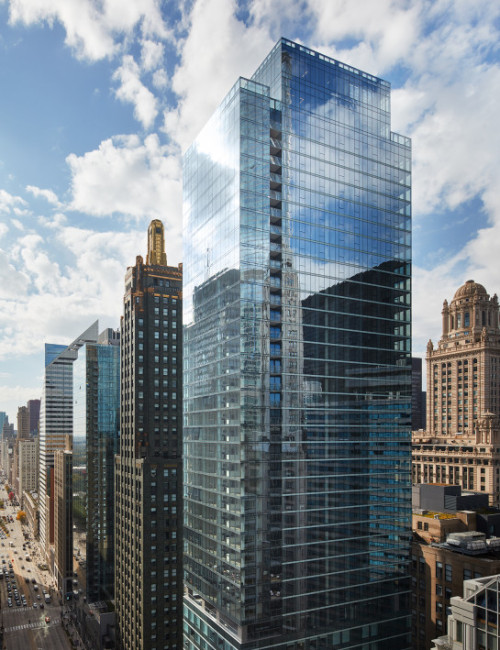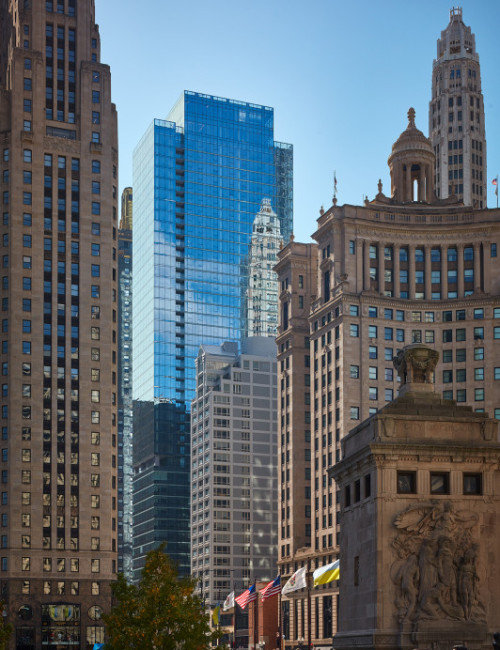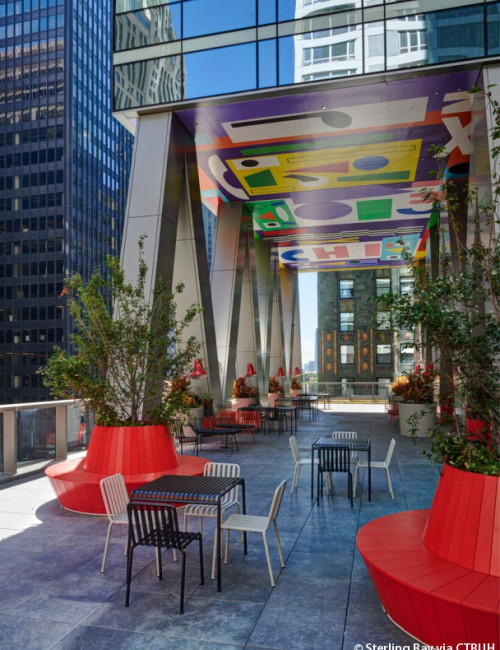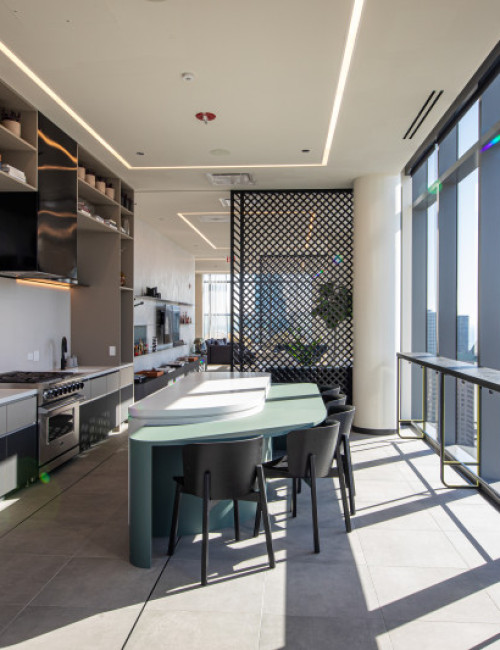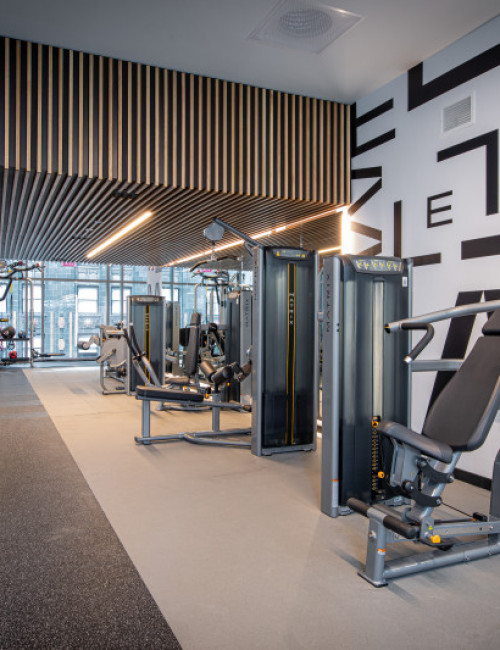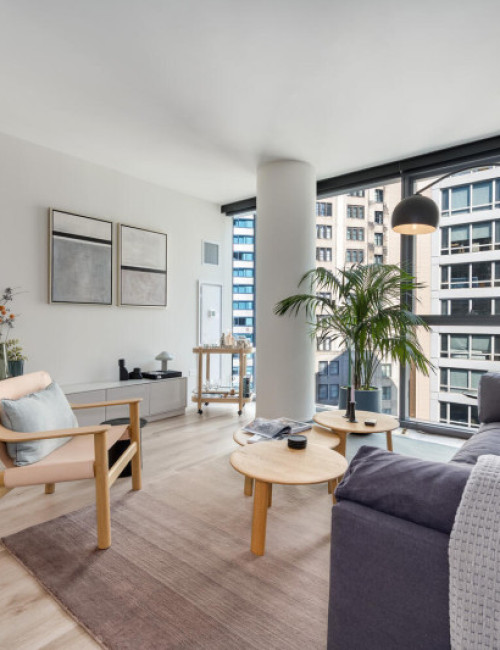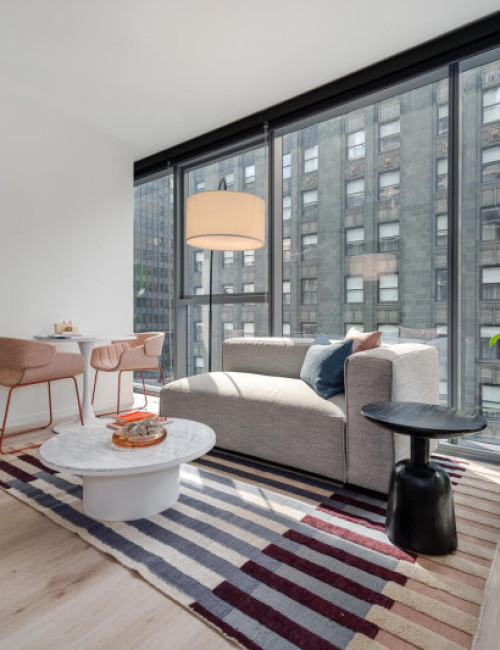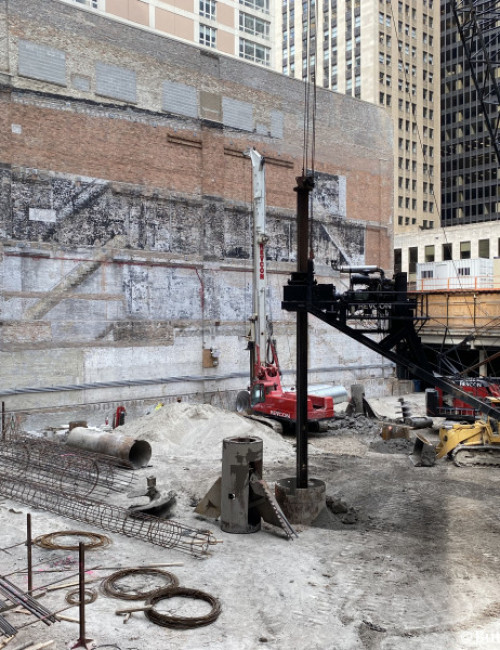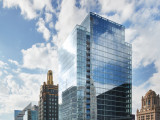Height rank
300 NMA
Chicago
- Facts
-
Metrics
You must be a CTBUH Member to view this resource.
Official Name
300 NMA
Other Names
Millie, citizenM Chicago Downtown
Type
Building
Status
Completed
Completion
2022
Country
City
Address
Function
A mixed-use tall building contains two or more functions (or uses), where each of the functions occupy a significant proportion of the tower's total space. Support areas such as car parks and mechanical plant space do not constitute mixed-use functions. Functions are denoted on CTBUH "Tallest Building" lists in descending order, e.g., "hotel/office" indicates hotel function above office function.
Residential / Hotel
Structural Material
Both the main vertical/lateral structural elements and the floor spanning systems are constructed from steel. Note that a building of steel construction with a floor system of concrete planks or concrete slab on top of steel beams is still considered an “all-steel” structure as the concrete elements are not acting as the primary structure.
All-Concrete
Both the main vertical/lateral structural elements and the floor spanning systems are constructed from concrete which has been cast in place and utilizes steel reinforcement bars and/or steel reinforced concrete which has been precast as individual components and assembled together on-site.
All-Timber
Both the main vertical/lateral structural elements and the floor spanning systems are constructed from timber. An all-timber structure may include the use of localized non-timber connections between timber elements. Note that a building of timber construction with a floor system of concrete planks or concrete slab on top of timber beams is still considered an “all-timber” structure as the concrete elements are not acting as the primary structure.
Mixed-Structure
Utilizes distinct systems (e.g. all-steel, all-concrete, all-timber), one on top of the other. For example, a Steel Over Concrete indicates an all-steel structural system located on top of an all-concrete structural system, with the opposite true of Concrete Over Steel.
Composite
A combination of materials (e.g. steel, concrete, timber) are used together in the main structural elements. Examples include buildings which utilize: steel columns with a floor system of reinforced concrete beams; a steel frame system with a concrete core; concrete-encased steel columns; concrete-filled steel tubes; etc. Where known, the CTBUH database breaks out the materials used within a composite building’s primary structural elements.
All-Concrete
Height
157.1 m / 515 ft
Floors Above Ground
47
Floors Below Ground
2
# of Apartments
289
# of Hotel Rooms
280
# of Parking Spaces
22
# of Elevators
10
Tower GFA
40,824 m² / 439,426 ft²
Rankings
-
By function
You must be a CTBUH Member to view this resource.
-
By material
You must be a CTBUH Member to view this resource.
Construction Schedule
Proposed
Construction Start
Completed
Owner/Developer
Architect
Usually involved in the front end design, with a "typical" condition being that of a leadership role through either Schematic Design or Design Development, and then a monitoring role through the CD and CA phases.
Structural Engineer
The Design Engineer is usually involved in the front end design, typically taking the leadership role in the Schematic Design and Design Development, and then a monitoring role through the CD and CA phases.
Other Consultant
Other Consultant refers to other organizations which provided significant consultation services for a building project (e.g. wind consultants, environmental consultants, fire and life safety consultants, etc).
Other Consultant refers to other organizations which provided significant consultation services for a building project (e.g. wind consultants, environmental consultants, fire and life safety consultants, etc).
Material Supplier
Material Supplier refers to organizations which supplied significant systems/materials for a building project (e.g. elevator suppliers, facade suppliers, etc).
Material Supplier refers to organizations which supplied significant systems/materials for a building project (e.g. elevator suppliers, facade suppliers, etc).
You must be a CTBUH Member to view this resource.
Owner
Citizen M; Magellan Development Group; Sterling Bay; Wanxiang America Real Estate Group
Developer
Magellan Development Group; Sterling Bay; Wanxiang America Real Estate Group
Architect
Usually involved in the front end design, with a "typical" condition being that of a leadership role through either Schematic Design or Design Development, and then a monitoring role through the CD and CA phases.
Structural Engineer
The Design Engineer is usually involved in the front end design, typically taking the leadership role in the Schematic Design and Design Development, and then a monitoring role through the CD and CA phases.
MEP Engineer
The Design Engineer is usually involved in the front end design, typically taking the leadership role in the Schematic Design and Design Development, and then a monitoring role through the CD and CA phases.
JMS Electric, Inc; The Hill Group
The Engineer of Record takes the balance of the engineering effort not executed by the “Design Engineer,” typically responsible for construction documents, conforming to local codes, etc.
Spaceco, Inc.
Contractor
The main contractor is the supervisory contractor of all construction work on a project, management of sub-contractors and vendors, etc. May be referred to as "Construction Manager," however, for consistency CTBUH uses the term "Main Contractor" exclusively.
Linn-Mathes, Inc.
Adjustable Concrete Construction
Reflection Window + Wall
Other Consultant
Other Consultant refers to other organizations which provided significant consultation services for a building project (e.g. wind consultants, environmental consultants, fire and life safety consultants, etc).
Other Consultant refers to other organizations which provided significant consultation services for a building project (e.g. wind consultants, environmental consultants, fire and life safety consultants, etc).
WT Group
M&R Electronic Systems
Spaceco, Inc.
The Hill Group
Concrete; Studio K Creative
Kettelkamp and Kettelkamp
M&R Electronic Systems
Citizen M
M&R Electronic Systems
Kimley Horn
Jenkins & Huntington
Material Supplier
Material Supplier refers to organizations which supplied significant systems/materials for a building project (e.g. elevator suppliers, facade suppliers, etc).
Material Supplier refers to organizations which supplied significant systems/materials for a building project (e.g. elevator suppliers, facade suppliers, etc).
Pittco Architectural Metals Incorporated; Reflection Window + Wall; Shanghai Yaohua Pilkington Glass Group Co., Ltd.
ALL Erection & Crane Rental Corp.
Global News

05 October 2021
Chicago Addition to “Millennium Mile” Tops Off
In Chicago, 300 NMA has reached its final height of 47 floors and 157.6 meters (517 feet). Located at 300 N. Michigan Avenue, the project...
Global News

05 October 2021
Chicago Addition to “Millennium Mile” Tops Off
In Chicago, 300 NMA has reached its final height of 47 floors and 157.6 meters (517 feet). Located at 300 N. Michigan Avenue, the project...

20 July 2020
A 47-Story High-Rise is Set to Break Ground in Chicago During the Pandemic
Two major Chicago developers are expected to break ground next month on a 47-story apartment and hotel tower on North Michigan Avenue, in what would...

13 August 2019
Glass-Clad Mixed-Use Tower to Replace Old Brick Building in Chicago
Just weeks after securing a zoning change from city officials, developer Sterling Bay is moving forward with its plans to demolish an older building on...

28 March 2019
Chicago to See a New Skyscraper on Michigan Avenue
One of Chicago’s busiest real estate developers wants to build a 47-story residential and hotel tower on a stretch of North Michigan. Sterling Bay is...
Subscribe below to receive periodic updates from CTBUH on the latest Tall Building and Urban news and CTBUH initiatives, including our monthly newsletter. Fields with a red asterisk (*) next to them are required.
View our privacy policy


